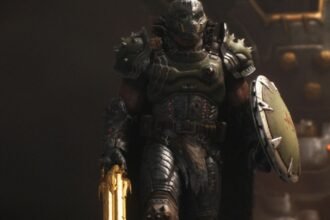Cosmology of Kyoto is a first-person horror exploration game that immerses players in a richly haunted yet surprisingly educational environment. Released in 1993, the game has since gained a cult following due to its unsettling depictions of suffering. Notably, film critic Roger Ebert, who was typically critical of video games, was so captivated by it that he devoted weeks to playing. Despite the acclaim, it failed commercially and never spawned a sequel—at least, that’s what was widely believed until recent developments.
In 2023, a game titled TRIPITAKA 玄奘三蔵求法の? appeared on Yahoo Japan, fetching a staggering $300 from an undisclosed buyer who initiated a bidding battle, yet remained silent about the game afterward. The auction was first brought to public attention by Mark Buckner during discussions among fans of the original eerie Japanese title.
While dedicated fans suspected that the creators of Cosmology might have considered a follow-up, solid evidence was scarce. The only hints of a sequel were found in the resumes of producers Hiroshi Ōnishi and Mori Kōichi. Additionally, an old website from a 1999 exhibition on the Silk Road referenced it. Although a fictional narrative, Cosmology was deeply rooted in the history of 10th century Japan and featured an in-game encyclopedia. This educational aspect would logically extend to any potential sequel, making it fit for a museum setting.
Amid these discussions, uncertainty lingered regarding whether the game had ever been produced or how far along it was in development. The news of the auction motivated video game scholar Bruno de Figueiredo to hunt down the new owner with hopes that they might share a copy online. Up until this point, little was known about the game, leading many to question its existence. Should it be real, its historical significance would surely draw interest from fans eager to experience it.
However, persuading collectors to reveal rare game copies is a daunting task; if a game is easily accessible, it loses its rarity. Possessing a rare title can enhance its value, and some collectors might feel compelled to safeguard culturally significant games for posterity, especially if they possess unopened copies. Furthermore, redistributing a game not personally created raises potential legal concerns.
Ultimately, the owner chose not to release the game for public play, although they did upload an hour of gameplay footage to YouTube. Titled TRIPITAKA, it didn’t explicitly claim to be a sequel, but its artistic style, historical context, and subtly eerie atmosphere positioned it similarly to Cosmology of Kyoto, leading fans to view it as a spiritual successor. The original game itself was crafted with input from Japanese museums.
For some enthusiasts, this footage was enough to rekindle their passion for a beloved game. While they couldn’t interact with it directly, the lengthy gameplay provided insight into the experience. Others, however, expressed frustration: why couldn’t the collector grasp the importance of sharing this game?
"I cannot stress enough how appalled I am that this piece of culture and art, which I am a huge fan of, isn’t being preserved and shared for others to enjoy," one YouTube commenter expressed. "Shame on you."
Undaunted, Bruno de Figueiredo persisted in his quest for TRIPITAKA. By 2025, his dedication paid off. On X, he announced that he had finally persuaded the collector to make the game available online after "years of pleas." He subsequently uploaded a playable ISO of the game, along with an extensive three-hour playthrough of a title once thought to be lost media.
De Figueiredo did not comment on requests for further information, but in a blog post, he articulated the significance of this discovery, stating, "the importance of this footage could hardly be overstated."
Referring to TRIPITAKA as one of the rarest games ever produced, De Figueiredo noted the single known copy’s unique status. The concepts of value and rarity fluctuate based on audience interest. However, the scarcity and uncertain fate of TRIPITAKA exemplify a troubling trend within the gaming industry, which often neglects to preserve its history. This neglect becomes even clearer with less notable titles than games that have garnered mixed reviews over the past two decades, suddenly commanding prices in the hundreds on resale platforms due to their obscurity.
Frank Cifaldi, founder of the Video Game History Foundation, emphasized that the 80s and 90s eras were particularly susceptible to such obscurity. Many games from that time, especially those that were self-published, lack any centralized authority on publication or a minimum production requirement, leading to situations where only a single copy exists.
"I would further suspect that numerous Japanese games and multimedia artifacts from this period are equally rare, yet remain under the radar due to their limited historical importance in Western narratives," Cifaldi remarked. "If you were to investigate the Game Preservation Society in Japan, I firmly believe you would uncover









